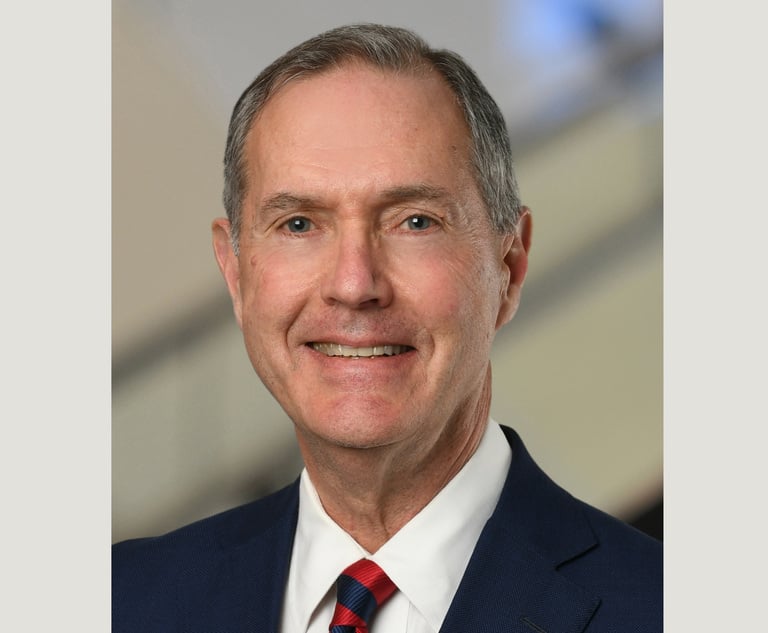Has the Magic Circle Lost Its Magic?
It may be time to reconsider the way we define and consider the so-called Magic Circle of elite U.K. firms.
April 09, 2020 at 01:00 AM
4 minute read
 Credit: Dmitriy Rybin/Shutterstock.com
Credit: Dmitriy Rybin/Shutterstock.com
The Magic Circle. It has a nice ring to it doesn't it? The U.K. legal industry has been largely defined by the existence of the five top firms for decades. But perhaps it is time we reconsidered the term.
Everyone knows what the Magic Circle means. It means Allen & Overy, Clifford Chance, Freshfields Bruckhaus Deringer, Linklaters and Slaughter and May; it means the dominant firms in the U.K. and Europe and beyond; it means the largest, most profitable, highest-quality institutions outside the United States.
But does it really mean all these things?
For a start, they are not the largest. Slaughter and May's domestic focus makes it much smaller than the rest, and there are other U.K.-heavy firms that bring in more revenue than the remaining four. Nor are they the most profitable. Macfarlanes has the second-highest average partner profits of any firm in the U.K.
Instead, the Magic Circle firms are so called because they operate in a different sphere than the rest of U.K. firms, representing the top blue-chip clients and leading investment banks on their most complex work, or so the mantra goes. That is true, but only to a point. According to the latest rankings, Slaughters, Allen & Overy, Linklaters and Freshfields hold the most relationships with FTSE 100 clients, but Herbert Smith Freehills comes in fifth ahead of Clifford Chance.
Many of the most lucrative clients also aren't listed. Private equity firms have come to dominate corporate dealmaking, comprising about a quarter of the value of all global mergers and acquisitions last year, and those relationships are mostly held by U.S. firms.
The Magic Circle firms may well do the complex, big-ticket work, but do they have a monopoly on it? That is an open question, especially because Kirkland & Ellis advised on the highest total value of European M&A deals in 2019.
Factor in the rest of the world and the picture is even less clear. Globally, Magic Circle firms are not among the top six by revenue, not in the top 12 by head count and not in the top 18 by average partner profits. Many in New York would question whether they are among the world's highest-quality institutions.
Of course, proponents of the moniker admit that it largely relates to the U.K. They argue that the band of five are set apart by something less tangible: brand. Clients using a Magic Circle firm can feel confident they will receive the best advice. And yet this also feels like a self-fulfilling argument, given that the brand rating of these firms is massively enhanced by the Magic Circle tag.
The truth is that the meaning of "Magic Circle" is at best vague. It hearkens back to a bygone era when the U.K. legal industry was more self-contained. Given that firms no longer operate only in the U.K., it seems strange to categorize them in a way that compares them only to U.K. rivals.
Trainees and a few of the leaders in the group still love to use the term. And why not? It signifies that they are in a club that produces excellent lawyers and has something special about it. But most partners at the firms privately admit that they don't really refer to it. Depending on their practice area, many don't even see each other as their main rivals.
Perhaps it would be more helpful to everyone to come up with a grouping of the elite international firms, based on size, geographical spread, partner profits and clients. If it included those with revenues of more than $1.5 billion, average partner profits of $3.5 million or more, and a sizable presence in the U.S., Europe and Asia, that group of five would be Kirkland & Ellis; Latham & Watkins; Skadden, Arps, Slate, Meagher & Flom; Simpson Thacher & Bartlett; and, at a push, Weil, Gotshal & Manges. Since 2007, the combined revenue of these five firms has grown at about twice the rate of the Magic Circle's.
There is something more magical about that group, even though—and I say this sadly as an Englishman—there is not one Magic Circle firm among them.
Email: [email protected]
This content has been archived. It is available through our partners, LexisNexis® and Bloomberg Law.
To view this content, please continue to their sites.
Not a Lexis Subscriber?
Subscribe Now
Not a Bloomberg Law Subscriber?
Subscribe Now
NOT FOR REPRINT
© 2025 ALM Global, LLC, All Rights Reserved. Request academic re-use from www.copyright.com. All other uses, submit a request to [email protected]. For more information visit Asset & Logo Licensing.
You Might Like
View All
Law Firms Look to Gen Z for AI Skills, as 'Data Becomes the Oil of Legal'

Law Firms Expand Scope of Immigration Expertise Amid Blitz of Trump Orders
6 minute read
Losses Mount at Morris Manning, but Departing Ex-Chair Stays Bullish About His Old Firm's Future
5 minute read
Law Firms Mentioned
Trending Stories
- 1Uber Files RICO Suit Against Plaintiff-Side Firms Alleging Fraudulent Injury Claims
- 2The Law Firm Disrupted: Scrutinizing the Elephant More Than the Mouse
- 3Inherent Diminished Value Damages Unavailable to 3rd-Party Claimants, Court Says
- 4Pa. Defense Firm Sued by Client Over Ex-Eagles Player's $43.5M Med Mal Win
- 5Losses Mount at Morris Manning, but Departing Ex-Chair Stays Bullish About His Old Firm's Future
Who Got The Work
J. Brugh Lower of Gibbons has entered an appearance for industrial equipment supplier Devco Corporation in a pending trademark infringement lawsuit. The suit, accusing the defendant of selling knock-off Graco products, was filed Dec. 18 in New Jersey District Court by Rivkin Radler on behalf of Graco Inc. and Graco Minnesota. The case, assigned to U.S. District Judge Zahid N. Quraishi, is 3:24-cv-11294, Graco Inc. et al v. Devco Corporation.
Who Got The Work
Rebecca Maller-Stein and Kent A. Yalowitz of Arnold & Porter Kaye Scholer have entered their appearances for Hanaco Venture Capital and its executives, Lior Prosor and David Frankel, in a pending securities lawsuit. The action, filed on Dec. 24 in New York Southern District Court by Zell, Aron & Co. on behalf of Goldeneye Advisors, accuses the defendants of negligently and fraudulently managing the plaintiff's $1 million investment. The case, assigned to U.S. District Judge Vernon S. Broderick, is 1:24-cv-09918, Goldeneye Advisors, LLC v. Hanaco Venture Capital, Ltd. et al.
Who Got The Work
Attorneys from A&O Shearman has stepped in as defense counsel for Toronto-Dominion Bank and other defendants in a pending securities class action. The suit, filed Dec. 11 in New York Southern District Court by Bleichmar Fonti & Auld, accuses the defendants of concealing the bank's 'pervasive' deficiencies in regards to its compliance with the Bank Secrecy Act and the quality of its anti-money laundering controls. The case, assigned to U.S. District Judge Arun Subramanian, is 1:24-cv-09445, Gonzalez v. The Toronto-Dominion Bank et al.
Who Got The Work
Crown Castle International, a Pennsylvania company providing shared communications infrastructure, has turned to Luke D. Wolf of Gordon Rees Scully Mansukhani to fend off a pending breach-of-contract lawsuit. The court action, filed Nov. 25 in Michigan Eastern District Court by Hooper Hathaway PC on behalf of The Town Residences LLC, accuses Crown Castle of failing to transfer approximately $30,000 in utility payments from T-Mobile in breach of a roof-top lease and assignment agreement. The case, assigned to U.S. District Judge Susan K. Declercq, is 2:24-cv-13131, The Town Residences LLC v. T-Mobile US, Inc. et al.
Who Got The Work
Wilfred P. Coronato and Daniel M. Schwartz of McCarter & English have stepped in as defense counsel to Electrolux Home Products Inc. in a pending product liability lawsuit. The court action, filed Nov. 26 in New York Eastern District Court by Poulos Lopiccolo PC and Nagel Rice LLP on behalf of David Stern, alleges that the defendant's refrigerators’ drawers and shelving repeatedly break and fall apart within months after purchase. The case, assigned to U.S. District Judge Joan M. Azrack, is 2:24-cv-08204, Stern v. Electrolux Home Products, Inc.
Featured Firms
Law Offices of Gary Martin Hays & Associates, P.C.
(470) 294-1674
Law Offices of Mark E. Salomone
(857) 444-6468
Smith & Hassler
(713) 739-1250










